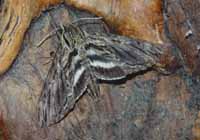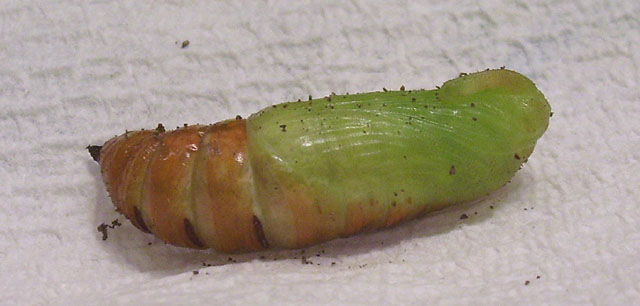Sphinginae subfamily
Sphingini tribe:
 |
This species has been enountered in Hartford County
as a stray from much further south.
The moth is a very strong
flier and is frequently encountered far north of its usual range.
|
 |
Ceratomia amyntor
USGS,
the Elm Sphinx or Four-horned Sphinx
The upperside of the forewing is brown with dark brown and white
markings including a white costal area near the wing base, dark
streaks along the veins, and a white spot in the cell.
|
 |
The upperside of the forewing is yellowish brown with no white
markings, but there are indistinct black lines and dashes.
The larvae feed in large groups and are much more
spectacular than the moths.
Catalpa is the larval host. Questionable! |
 |
The upperside of the forewing is pale brownish gray with wavy black
and white lines and a black-outlined white cell spot.
Note black and white collar separating thorax from abdomen. |
 |
The upperside of the forewing is dark brown with a dusting of white
scales. Some moths have patches of reddish or yellowish brown on the
wings.
|
 |
The upperside of the forewing is gray with heavy black bands. The
upperside of the hindwing is brownish gray with no markings.
|
 |
The upperside is of the forewing is gray with two (sometimes one or
three) black dashes near the wing center; other markings are usually
diffuse. The upperside of the hindwing is a uniform brown-gray.
|
 |
This species is possibly present in Hartford County.
The upperside of the forewing is gray-brown with wavy lines, black dashes, and one or
two small white spots near the center of the costa.
|
 |
The upperside of forewing is gray to grayish brown with a black line
running from the middle of the costa to the middle of the outer
margin; the line may be broken near the margin. There is a splash of
brown around the cell spot.
|
 |
The moth abdomen usually has five but sometimes six pairs of yellow
bands. The upperside of the forewing is blurry brown and gray. If you
grow tomatoes, you have probably encountered it.
|
 |
The abdomen usually has six pairs of yellow bands, broken across the
back. The sixth set of markings is quite small.
The upperside of the forewing has indistinct black, brown, and white
markings.
Larvae get very large and can strip a tomato plant. |
 | The upperside of the forewing is gray with indistinct black and
white markings. There is a series of black dashes
from the base to the tip, and a small white cell spot.
|
 |
Sphinx chersis
USGS, the Northern Ash Sphinx or Great Ash
Sphinx
The upperside of the forewing is soft dark gray to blue-gray with
a series of black dashes, one of which reaches the wing tip.
|
 |
This species is not officially recorded, but I suspect it is
present. We have them on P.E.I., but I do not see them nearly as frequently as I see the other Sphingidae. |
 |
The upperside of the forewing ranges from brown with black borders through brownish gray with paler borders to pale gray with no
borders. Dashes, submarginal line, and cell spot are usually weak. |
 |
This species is now confirmed in Hartford via
larva find by Rebecca Gregory.
I have taken them on P.E.I., Canada, and reared them on
lilac. At rest the hindwings are usually completely covered.
|
Smerinthini Tribe:
 |
The adults are also highly variable; sometimes wings of an individual
may be all one color or may have several colors, ranging from pale to
dark brown, and may have a white or pink tinge.
|
 |
This moth has a large, heavy body, and females can be remarkably
plump. Generally found more to the north.
|
 |
Paonias astylus, the Huckleberry Sphinx (wingspan 55-65 mm), ranges
from Maine south to Florida, west to Missouri and Mississippi.
It tends to be uncommon.
|
 |
Named for the dull grey-blue spot in the hindwing, this moth has a
wide distribution and is probably common in Hartford County.
I regularly see them on Prince Edward Island, and they are reported
as far south as Florida. |
 |
Paonias myops
USGS, the Small-eyed Sphinx
Named for the small eye-spot in the hindwing, this moth has a wide distribution
and is probably common in Hartford County.
I regularly see them on Prince Edward Island, and they are reported as far south as Florida.
|
 |
This moth is widely distributed and fairly common so I suspect it is
in Hartford County.
Along the East Coast, it flies from P.E.I. to Florida. |
Macroglossinae subfamily
Dilophonotini tribe:
 |
Hemaris thysbe
USGS, the Hummingbird Clearwing
This interesting day flier is confirmed for Hartford County.
They are widely distributed in the east from P.E.I. to Florida. |
 |
Hemaris gracilis
WO,
The Slender Clearwing or Graceful Clearwing
This day flier is not commonly reported, but may be present. |
See Hemaris comparison.
 |
Hemaris diffinis
USGS, the Snowberry Clearwing or
Bumblebee Moth
This moth is widely distributed and is probably found in Hartford.
|
Philampelini tribe:
 |
This moth is not officially reported for Hartford,
but it is fairly often reported
along the coast from southern New Jersey
to central Maine.
Note the differences between this moth and the Pandorus Sphinx. |
 |
If you have Grape or Virginia Creeper nearby, then you probably have
this species.
I often get asked to identify larvae from areas where they have not
previously been reported.
|
Macroglossini tribe:
 |
This day flier is widely distributed.
If you have Virginia Creeper, you
probably have the Nessus Sphinx. Two bright, distinct, narrow
yellow
bands are often visible on the abdomen.
|
 |
They are common in New Jersey and common
here on Prince Edward Island.
You will often see this species listed as Darapsa pholus,
especially in older literature. It is almost certainly present.
|
 |
Darapsa myron
USGS, the Virginia Creeper Sphinx or the Grapevine Sphinx
This moth is recorded on the U.S.G.S. site for Hartford County.
It is widely reported as far north as southern Maine. If you have the
foodplants indicated in the common names, you probably have this
species nearby. |
 |
If you have hydrangea growing near a stream, then you may have the
Hydrnagea Sphinx. It has not been widely reported, however, and
probably is uncommon.
|
 |
The moth's outer margin of the forewing is deeply scalloped.
The upperside is light brown with dark brown markings.
There is a small black and white spot near the tip.
|
 |
Hyles gallii
USGS, the Bedstraw Hawk Moth
or Gallium Sphinx
This species is reported in Hartford County.
Some years I see them on P.E.I., some years, I do not.
|
 |
Hyles lineata
USGS, the White-lined Sphinx
This species is reported in Hartford County.
It is a strong migrator from the south,
and there are records from the east, west and to the north. |
 |
This moth is very much under reported. It is a
rapid day flier so is probably not in too many collections. Grape is a popular larval host.
|
 |
This moth is much more common to the south. It is a strong migrant,
however and has been recorded in Hartford County.
|
|
|


